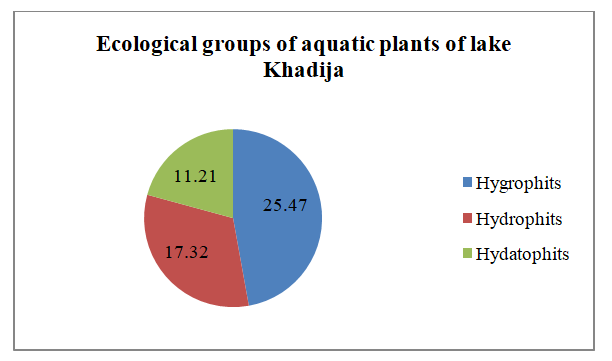-
Paper Information
- Paper Submission
-
Journal Information
- About This Journal
- Editorial Board
- Current Issue
- Archive
- Author Guidelines
- Contact Us
International Journal of Genetic Engineering
p-ISSN: 2167-7239 e-ISSN: 2167-7220
2024; 12(1): 5-8
doi:10.5923/j.ijge.20241201.02
Received: Jan. 12, 2024; Accepted: Feb. 3, 2024; Published: Feb. 8, 2024

New Information on the Ecological Groups of High Water Plants of Khadycha Lake, Bukhara Region
Rakhimov Jonibek Rashitovich
Bukhara State University Associate Doctorate, Uzbekistan
Correspondence to: Rakhimov Jonibek Rashitovich , Bukhara State University Associate Doctorate, Uzbekistan.
Copyright © 2024 The Author(s). Published by Scientific & Academic Publishing.
This work is licensed under the Creative Commons Attribution International License (CC BY).
http://creativecommons.org/licenses/by/4.0/

The article analyzes materials collected during 2018-2023. New information is presented about theеcological groups of aquatic plants of Lake Khadichkha in the Bukhara region. In particular, the importance of dominant species in fisheries has been determined. When monitoring the ecological condition of water bodies in our republic, special attention is paid to continuous monitoring of the biodiversity of hydrobionts in it, especially to the study of the flora of water bodies, and to the use of its useful species in the leading sectors of the national economy.
Keywords: Uzbekistan, Bukhara Higher aquatic plants, Kyzylkum, Southwestern, Hygrophytes, Hydrophytes, Hydatophytes, Flora of the area, Reservoirs
Cite this paper: Rakhimov Jonibek Rashitovich , New Information on the Ecological Groups of High Water Plants of Khadycha Lake, Bukhara Region, International Journal of Genetic Engineering, Vol. 12 No. 1, 2024, pp. 5-8. doi: 10.5923/j.ijge.20241201.02.
1. Introduction
- In this regard, among other things, important results are being achieved in terms of studying biological properties of useful and medicinal plants growing in water bodies, species used in animal husbandry, poultry farming, fisheries and pharmaceuticals, reproduction and supply of raw materials for industry. The latest information about the flora of Bukhara region can be found in the information of H.K. Esanov and others. These articles provide information on the distribution and importance of 59 families, 294 genera, and 529 species of plants found in the research areas. The main part of the South-Western Kyzylkum region is the Bukhara region. Among the flora of this region, it is possible to note high water plants found in the waters of reservoirs. These aquatic plants play an important role in maintaining the biodiversity of water bodies. High water plants There are 70 types of high plants belonging to 24 families in South-Western Kyzylkum water bodies [2]. T.N. According to Kholmuradova, a preliminary list of high-water and waterside plants distributed in the Kashkadarya water basin was given, and it was determined that 77 species of high-water and waterside plants belonging to 24 families and 44 genera are distributed [1]. Lake Khadichha is one of the abandoned lakes in the Bukhara region, located in the south-east of the region. This lake is the largest lake in the Qarovulbazar oasis. Lake Khadija is located on the right bank of the Amu-Bukhara Motor Canal (ABMK) near the Havana bridge (Havana most). Khadichhalake was created in the place of ancient valleys (deep depressions) of the Kashkadarya basin. Lake Khadicha is separated from ABMK by a 50-100 m wide road.
2. Materials and Methods
- But the water of ABMK does not fall into Khadicha Lake. The water source of Lake Khadichha is mainly the Karshi collector (flowing from the territory of Kashkadarya region). Water comes through 5 pipes with a diameter of 1 meter. However, the amount of water poured into the lake from this collector is not evenly distributed throughout the year. Oil and gas drilling is carried out 10-15 km from the Khadicha Lake area, and a collector formed from waste water of an oil refinery at a distance of 50-65 km also discharges its water into a separate ditch. As a result of our scientific work carried out in 2018-2023, a list of 53 species of high water plants belonging to 22 families was compiled for the first time in Khadicha Lake, located in Bukhara region. (1 table)
|
3. Results and Discussions
- Until now, the aquatic and wetland vegetation of water bodies in Uzbekistan has not been fully studied. Therefore, during our research, we studied the high-water and waterside plants of Lake Khadichha, Bukhara region. 25 types of hygrophytes, 11 types of hydrophytes, and 17 types of hydatophytes were found for Lake Khadicha. (Figure 1)
 | Figure 1. Ecological groups of aquatic plants of Lake Khadija |
4. Conclusions
- In conclusion, we can say that it is of great importance to study biological resources, which are the main elements of the existing natural aquatic ecosystem, and to use them rationally in the field of fisheries, and to increase the groups that will be the objects of necessary fish food.
 Abstract
Abstract Reference
Reference Full-Text PDF
Full-Text PDF Full-text HTML
Full-text HTML